I’m really digging these imbalance problems I came up with. Friday was our last day before spring break, and I worked on them with every one of my classes. They liked the puzzles, but the examples I had were a bit too easy, so our real goal was creating good imbalance problems of our own, which is way harder than solving them. My 5th graders had the best ideas for tweaking the puzzles and making new ones. It was cool for them to realize you couldn’t just draw a picture, because sometimes they were impossible, and other times they didn’t give enough information. I’ll hopefully post some of their puzzles after break.
I’ve been working the last two days on my own puzzles, and I’ve never had a better time working with inequalities in my life. They have a way of sneaky way of revealing information that I’m really liking. 2x<y+z tells you some interesting stuff, for example. Further down I’ll talk about how I write them, what makes for a good puzzles, and the puzzle-writing contest I’m having, but right now, why don’t you try some out? I’m especially proud of 6, 9, 10, 11, and 12. ENJOY!
In each case, order the three shapes by weight
 |
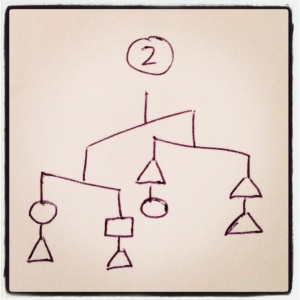 |
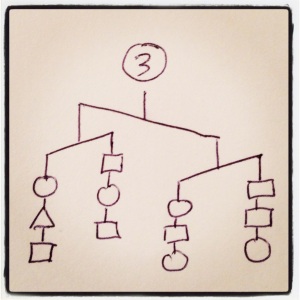 |
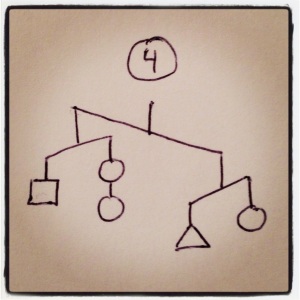 |
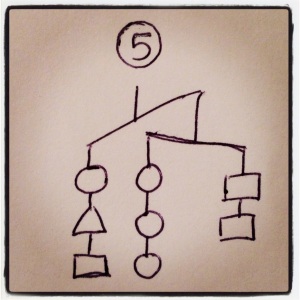 |
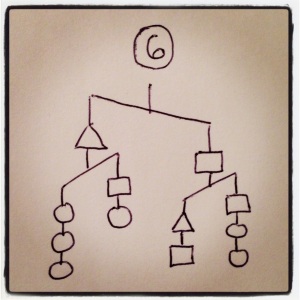 |
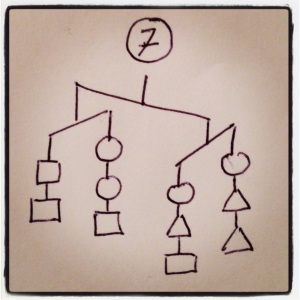 |
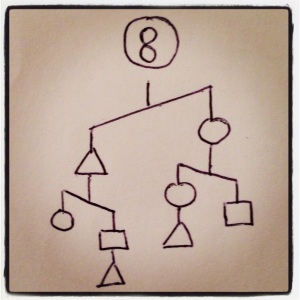 |
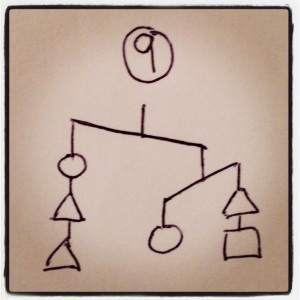 |
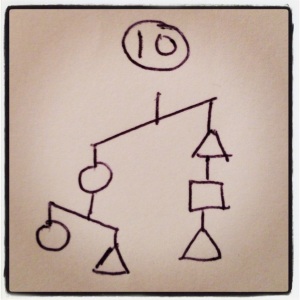 |
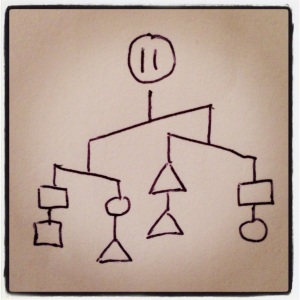 |
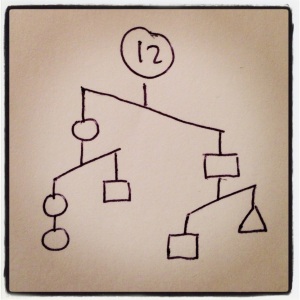 |
Fun, right? As I’ve said, I’m offering a prize for great imbalance puzzle-writing. My favorite two puzzlists will receive a print of their choosing from the Stars of the Mind’s Sky series, up to 12″x12″. Just post your problem(s) in the comments or email lostinrecursion@gmail.com.
 So what makes a good puzzle? It’s a matter of taste (like a lot of mathematics actually), but I tend to like my puzzles pretty simple. A big, messy, just plain hard puzzle is just a hassle, but something compact and tricky to untangle, now that’s what I like. I love when a puzzle requires me to think in a new way or exploit some clever little detail I hadn’t considered. Nathan Chow sent me a really clever puzzle design that implements “entangled imbalances,” which I completely love. Doesn’t it inspire you to write your own? I could have cropped it so it didn’t look like an iPhone app, but I love art that reveals the creative process.
So what makes a good puzzle? It’s a matter of taste (like a lot of mathematics actually), but I tend to like my puzzles pretty simple. A big, messy, just plain hard puzzle is just a hassle, but something compact and tricky to untangle, now that’s what I like. I love when a puzzle requires me to think in a new way or exploit some clever little detail I hadn’t considered. Nathan Chow sent me a really clever puzzle design that implements “entangled imbalances,” which I completely love. Doesn’t it inspire you to write your own? I could have cropped it so it didn’t look like an iPhone app, but I love art that reveals the creative process.
In case you’re wanting tips for writing these puzzles, I’ll tell you about my process. I usually start with a single idea or part of the picture. The key is thinking about what information it gives the solver, and what other information they’ll need to finish the problem. After that it’s just a matter of cleverly revealing that information and piecing them together. Maybe solving the problems above in order will give you a sense of the new ideas I had and was able to wrinkle in.
I hope you’re loving these as much as I am, and I’m dying to see your creations. Mostly because I want some to solve!!!


Paul, that is pretty awesome! I haven’t seen this before, but it seems a great resource for both problem solving and the kind of problem finding David Perkins talks about. Thanks for sharing!
My pleasure, Harvey. Thanks for commenting, and thanks for your enthusiasm. If you write any of your own, please submit them to the contest. I’d love to see.
Pingback: Harvard physics problems of the week | scenic-science + thematic-mathematics | same
Your blog post inspired us to put up a related problem about mail bags:
http://fivetriangles.blogspot.com/2013/03/50-mail-bags.html
Pingback: Monday Fun | Kitten's Purring
Pingback: Logic Puzzle: Imbalance Problems | Let's Play Math!
Pingback: Algebra Explorations Before Algebra | CAS Musings
Pingback: Still imbalanced | CAS Musings
Hey, I tried out the Imbalance Problems and I’d like to compare my answers with you but without making it public so I don’t ruin it for others. How can I do that with you?
~Nick
https://sites.google.com/site/mathynick/
You could send me an email, or better yet, write your answers up in a google doc and make it viewable to the public. You could post the link here. As of right now, I don’t have an answer key, so that would actually be helpful. Ill go through and verify.
Hey, I’ve written a program that computes the solution to simple inbalance problems. I’ve included the output of a test run on the 12 problems above and the 3 problems from the next post (my program can’t solve #13, though, because it uses equality). If you’re interested in the algorithm: My program simply translates the imbalance problem to a system of linear inequalities, which can be solved with a standard linear programming library. So, without further ado, here’s my code:
This file contains bidirectional Unicode text that may be interpreted or compiled differently than what appears below. To review, open the file in an editor that reveals hidden Unicode characters.
Learn more about bidirectional Unicode characters
ImbalanceSolver.hs
hosted with ❤ by GitHub
This file contains bidirectional Unicode text that may be interpreted or compiled differently than what appears below. To review, open the file in an editor that reveals hidden Unicode characters.
Learn more about bidirectional Unicode characters
output.txt
hosted with ❤ by GitHub
That’s really cool, Tim. You’re right though, 13 has some real problems, and not just because it uses equality. I’m going to replace it at some point.
Thanks for commenting!
Pingback: Marvelous #Math Monday 04-01-13 | Joy of Education
Pingback: Stars of the Mind’s Sky with Diagrams | The Math Less Traveled
Pingback: Day 119: Imbalance Problem Vivant | Lanier Post-a-Lot
I think the basic thinking is considering what data it gives the solver, and what other data they’ll have to complete the issue. After that its simply a matter of keenly uncovering that data and sorting them out. Maybe tackling the issues above in place will provide for you a feeling of the new thoughts I had and could wrinkle in.
Hey thanks for the comment!
Pingback: Monday Fun | Kitten's Purring
Any chance you will be at NCTM one D.C. this year? I’ve been issuing these puzzles for years now.
Hey Daniel! That’s awesome you’ve found them so useful. I do t have plans to be at NCTM. Where are you from?
Rereading “Playing with Math” by Sue VanHattum. (You’re in there.) 🙂
Oh yeah! Awesome. Thanks for checking in!